From jackets to blankets to onesies to dog sweaters, fleece is a bit of a miracle product. Well, if humans can create miracles — fleece is made from petroleum and was engineered by the fabric gods of the 1970s. Fleece is synonymous with cozy, and fleece jackets offer a solid synthetic layer of warmth, breathability, and style for backcountry and frontcountry use.
To skip the history lesson, head straight over to our list of the best fleece jackets available today. Otherwise, if you’re here for the deep dive, keep on reading.
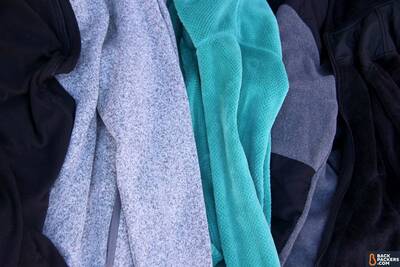
Below you’ll find every element of fleece jackets explored, from the oil-drenched history to the best uses for different Backpacker Types. We aim to offer some very specific questions too: What is fleece fabric? Is fleece warm? Is fleece breathable? And what’s recycled fleece? We cover so much there’s a handy table of contents below to help you navigate the high-loft (inherently treacherous) waters of fleece:
- History of Fleece
- Fabric
- Warmth and Breathability
- Features
- Layering Fleece
- Recycled Fleece
- Backpacker Types
History of Fleece
If you’re a history buff with a penchant for synthetic clothing, this will fascinate you. It’s the tale of Malden Mills, a synthetic fabric manufacturer, who, between ’79 and ‘81, created Polar fleece. This fabric is the foundation upon which all past and present fleece is built.
Malden Mills and then-owner Aaron Feuerstein used petroleum as polyester to create the fabric. The scientists took polyester yarn — already a thing, called PET, or polyethylene terephthalate — and wound it into a dense fabric. They then brushed the fibers out, which greatly increased the volume, and modern fleece was born.
Malden Mills did all this because, in the first half of the 20th century, it was known for manufacturing high-quality wool garments for general and military use. Malden Mills’ goal in spinning polyester yarn into thick slabs of fabric was to replicate the insulating properties of wool while leaving behind wool’s major issues: it’s not great when wet, it’s heavy, and you need animals to get it.
Oil, they thought! There’s oil in the ground and it will be clothes!
Right around this time super-hip and little-known outdoor company Patagonia was sniffing around for some new fabric that would outperform wool and other fabrics for backcountry alpine use. Long story short: owner Yvon Chouinard teamed up with Malden Mills, got the fabric dialed in, and debuted Synchilla fleece in the legendary Snap-T Pullover.
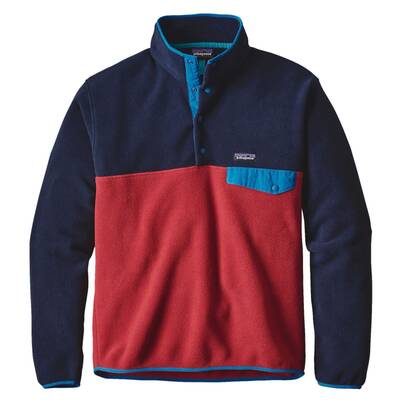
Today’s Synchilla Snap-T Pullover. Pretty much as it was in 1985. Image courtesy Patagonia, All Rights Reserved.
Finally, in the legend that is Malden Mills and fleece, then-owner Feuerstein decided not to patent the fabric. Yes, that’s right — instead of being greedy and exclusionary, he opened up fleece to the masses, allowing for the incredibly widespread adoption and innovation of fleece for the future.
Malden Mills Becomes Polartec LLC
Malden Mills was riding high for a while, but went through various financial troubles as the years wore on. In 2007 the company went bankrupt, had its assets purchased, and was rebranded into Polartec LLC.

The bummer of a company’s slow death aside, these “assets” allowed Polartec to rise to prominence in the field of innovative synthetic fabric, specifically with fleece.
In the outdoor industry, Polartec reigns supreme. There are other fleece manufacturers, but most of the big brands choose from the delicious smorgasbord that Polartec now offers. There are 400 different fabrics on tap. Yes, 400. Not all of these are used by the outdoor industry; Polartec manufactures for all sorts of applications.

Base and Insulation are most common in the outdoor industry.
With the history squared away, let’s dive into the synthetic coziness of fleece itself.
What is Fleece Fabric?
If there’s one all-important aspect of fleece, it’s the fabric itself. Besides the zippers, snaps, adjustable hems, and pretty colors, a fleece jacket is just made up of fleece. Yes, that’s a tautology, but it’s very different from other types of jackets, like down jackets, in which there are entirely different layers that make up the whole coat.
A fleece jacket is 100% fleece — except for those things I mentioned above. But what is fleece fabric?
Getting to know fleece as a fabric and how it’s marketed is simple at the start, and very complicated by the end. Demystification commencing…
Fabric Weight
Arguably the most important aspect of fleece is the fabric weight. This has everything to do with coziness, warmth, breathability, and use cases, and nothing to do with the workout routine of polyester (unceasing Crossfit).
Fleece fabric is weighed in grams per meter squared (or ounces per yard squared if you’re American), and the categories below are broken up by that specific metric. It’s not always easy to spot this number on a given product, which is an industry issue. Manufacturers often want to justify their fleece for many activities, when in reality it works best for one or two applications. To get a gauge on the actual thickness, hunt for how many grams or ounces the fabric is per square meter or yard.
Fleece is generally broken up into three main weights:
1. Lightweight Fleece Fabric — 100 g/m2
Lightweight, as you can probably guess, is a thinner material. Fleece that’s lightweight is often more packable, breathable, and doesn’t insulate as well as thicker fleece. It’s optimal for high-output activities, like hiking, running, or biking.

A lightweight fleece can be soft and fuzzy or very smooth and gridded. This one is fuzzy. The weight is easier to feel when worn.
2. Midweight Fleece Fabric– 200 g/m2
Midweight is a medium-thickness fleece. These jackets are typically the most versatile because they breathe decently but still provide a fair amount of warmth. If you need a fleece that works for some high-output activities but can still function as a warm layer on cool days, midweight is your best bet.
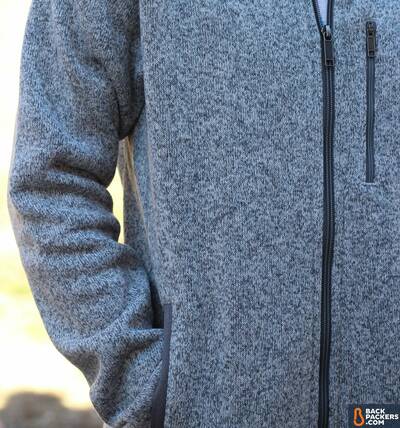
Midweight fleece is sometimes knitted, sometimes lofted. This knitted fleece is actually closer to 280 g/m2, but it feels like a midweight.
3. Heavyweight Fleece Fabric– 300 g/m2
Heavyweight fleece is the bouncer at a nightclub: the cold stays out, the sweat stays in. As types of fleece fabric have progressed, heavyweight is not used as much as it once was, especially in the outdoor crowd. However, if you want a fleece that also serves as a decent outer layer, heavyweight is where you’re at.
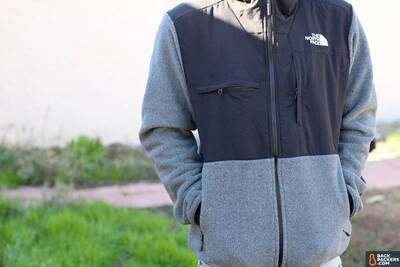
Heavyweight fleece is, well, heavy. Thicker, often cut baggier, and usually paired with other fabrics for extra wind and water resistance.
Hybrids and Variations of Fleece Fabric
You can find the above metrics in Polartec’s Classic line, which corresponds nicely with 100, 200, and 300 weights, but the market and time have complicated fleece fabric.
Today there are hybrid fleeces that use multiple weights of fleece on a single piece, like the Patagonia R2 Fleece, which has a thinner material in “active” areas and thicker fleece over your core warming areas. Then some jackets use different materials altogether, like The North Face Denali 2, which has nylon wind-blocking panels in key areas.
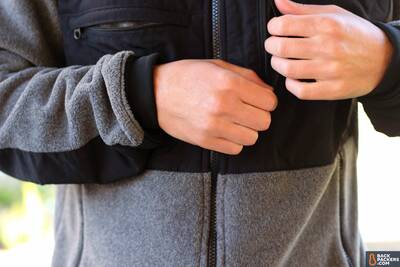
The North Face Denali 2 has stretchy fabric along the forearms, jersey cuffs, and a nylon panel over the chest for water and wind resistance.
There are also fleeces that fall somewhere between the general weights. These are different due to the way the fleece was brushed, lofted, and knitted together.
As a rule of thumb, it’s best ti check the fabric weight, then feel it, and wear it before purchase. Fleece is created in so many variations now that it can be difficult to navigate; how it feels is still the best test.
High Loft versus Tightly Woven Fleece Fabric
The next main element in fleece, and the one most people will care about, is whether or not it’s a high loft or tightly woven. That sounds technical and boring, but the end result is a fleece that feels like fur, or a fleece that feels like cotton.
Remember that fleece is technically little strands of oil, so the process of transmuting it into insulating clothing can vary a good amount. Polartec and others have taken this to the next level and offer a wide range of fleece fabrics, each of which has a slightly different texture and end result.
High Loft
High loft fleece is, on the whole, warmer. Fleece heat retention works because there are tiny pockets of air in the fabric, which trap and hold your body heat, thereby warming you up. (The same process is used in down!) A fleece that has been lofted greatly will have larger pockets for air.
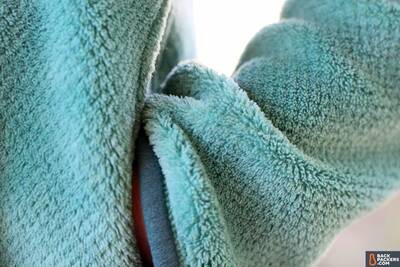
High loft equals high warmth and maximum coziness.
However, this warmth is coupled with what weight the fabric is, so you can’t be sure about that warmth until you try it on.
The high loft also changes the nature of the fabric, creating a more plush, cozy, and fur-like material. Polartec makes a specific High Loft fleece, which is used in popular jackets like the Mountain Hardwear Polartec High Loft Jacket. The further you go down this road the fluffier the fleece gets, and the more ooh’s and ahh’s you get as people stroke your coat.
Tightly Woven
The opposite of high loft is tightly woven fleece, which, for lack of a better description, is closer to the feel of cotton. It’s smooth, compact, and doesn’t insulate heat as well. Tightly woven fleece is used in jackets that need to be seriously compressed for, say, a backpacking trip, or for those who want a very slim layer.
As you can probably surmise, tightly woven fleece is not as warm because it doesn’t have huge pockets for air. It takes up less room and breathes a lot better than high-loft fleece.
The epitome of this is micro-grid fleece, tightly woven fleece that appears as small squares. Polartec’s version is the Power Grid fabric, which utilizes squares and strafing lines above and below the squares for the ultimate in low-profile, breathable fleece.
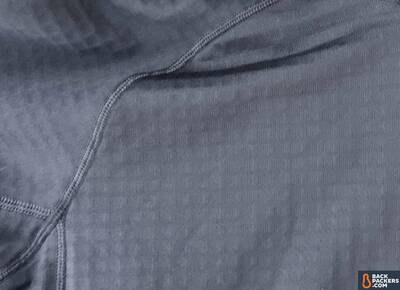
Microgrid fleece is thin, lightweight, and breathes extremely well.
The In-betweens
As mentioned, Polartec offers over 400 different fabrics, many of which are variations of fleece. High lofts and tight weaves are the extremes; there are plenty of fleeces that have a more classic feel like the fleece jacket you grew up with (from Gap) or the fleece throw blanket on your couch.
For many, fleece is about feel, so go feel it.
Is Fleece Warm, and Is Fleece Breathable?
We’ve touched on warmth and breathability above as it relates to the fabric type and quality, but these two elements of fleece are essential to understanding what to purchase. You are buying a fleece to increase your warmth overall, or to get a more breathable insulating layer. Both of these are in direct relationship to water in terms of how to stay dry from rain and sweat.
Is Fleece Warm?
Fleece is warm, no doubt about it. Unlike dumping petroleum all over your body, the synthetic fibers, when spun and lofted, magically turn into a jacket that traps your body’s heat in small pockets. This process is very similar to down, yet fleece is not as warm as down for the weight. And down jackets suffer from a serious lack of breathability…
Is Fleece Breathable?
You could argue that the key to a fleece jacket is its breathability. When hiking you want a layer to fend off a morning or evening chill, but you don’t want to sweat so much you’re hot and gross. When the right fleece jacket is paired with the right activity your problems are solved.
Keep in mind that the lighter fabric fleece is more breathable. If you use a high-lofted heavyweight fleece it will not breathe, and you will not want to hike up a hill with it, let alone trek miles with a fully loaded backpack on.
Does Fleece Repel Water?
Oh, water. How we love thee, and how we fear thee. Much of a backpacker’s life is making sure they are prepared. Food can run out, an ankle can twist, and you might get lost. Most commonly, though, it starts to rain. And rain sucks when you’re miles away from civilization.
Fleece, by nature, is hydrophobic. This means its threads cannot absorb water. (What petroleum-based product does?) So, yes, fleece holds up in light rain. However, it’s not waterproof at all, and should not be mistaken for a rain shell, ever.
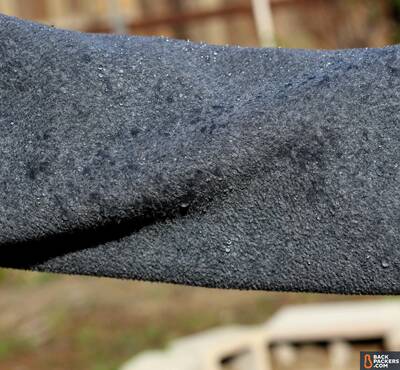
We sprayed this fleece with a hose. It got wet, but it also beaded off water better than you might think.
The fact that its fibers don’t absorb water just means that the coat will dry out quickly if it does get wet, and it won’t be totally useless in warming you up when wet. That said, fleece can wet out completely, and it’s usually pretty soppy and gross when that happens. We don’t recommend trying it out unless you’re close to home.
This hydrophobic property also means that the fleece jacket will kindly refuse to let sweat escape from your body. Water from the sky, water from your skin — it’s all water to fleece. One of the biggest issues with fleece in the early years was that it simply could not be used for intense activities because it was so warm that it made users sweat profusely, and that sweat was trapped.
Go for an uphill bike ride with a heavyweight fleece and you’ll see exactly what I mean.
The main points of engineering for fleece over the last three decades have been about making it more breathable. Polartec and others have managed this by making very lightweight and uniquely shaped fleece like the microgrid.
Features of Fleece Jackets
Who doesn’t love features? Zippers, pockets, hoods, and elasticity. With fleece, you don’t get much more than that, but each of those is essential.
Zippers on Fleece Jackets
Most fleeces are zippered. This helps them breathe, and the general populace has come to expect a zipper in a coat. You’ll typically find full-length zippers down the front, but 1/4 zips are very popular when the fleece is lightweight.
You’ll also find zippered pockets…
Pockets on Fleece Jackets
The ability to store stuff in a jacket is almost essential. There are special use cases where you won’t need one, but having a pocket on your fleece makes a lot of sense.
There are often two zippered hand-warmer pockets on fleece jackets, meant for storing your hands (duh) or small items, like a wallet or phone. On a backpacking trip, these pockets are typically empty until you set up camp; then they hold a headlamp, map, or lighter.
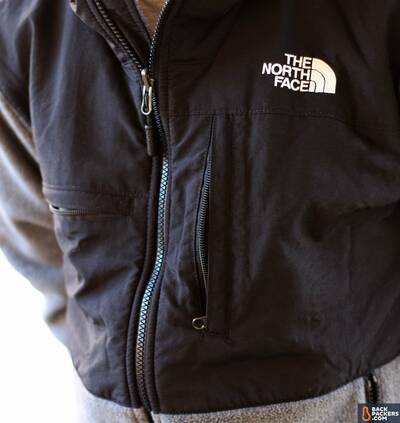
Two zippered chest pockets on this fleece jacket and a burly full-length main zipper.
Zippered chest pockets are also popular. These are typically smaller than hand-warmer pockets and store smaller items, like a lighter, ID, or daily supplements.
Some fleece jackets have all three pockets, some have just the chest pocket, and some have no pockets at all. What do you need out of your fleece?
Do Fleece Jackets Need Hoods?
A great debate among outdoor enthusiasts, hoods typically come down to preference and your other clothes. There are plenty of technical fleeces that come with hoods, or super heavyweight fleeces that come with hoods.
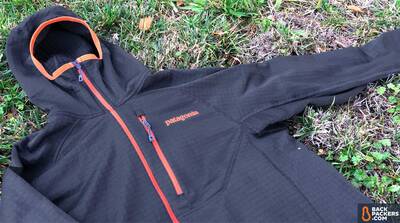
Balaclava style hood keeps in the most warmth AND makes you look like a ninja.
On the technical side, a hood is just added functionality in a lightweight piece of kit. Fleece hoods are usually balaclava style, come up past your chin, and cinch tightly over your head. This can save your ears when it’s brisk and keeps you from finding your beanie in your pack.
Super heavyweight fleeces also offer hoods, but they’re of the cozy variety. Not form-fitting at all, these fleece hoods are oversized, incredibly soft, and can be found running amok on college campuses.
When you decide to get (or not get) a hood, think about the rest of your layering system. Will it be redundant? Do you like beanies more? Will it be uncomfortable under your rain shell hood when the storms pour overhead?
Some Fleece Jackets Have Elastic
If you’re confused, no, fleece is not elastic. However, manufacturers throw elasticity into parts of a fleece jacket fleece to increase their warmth.
A solid fleece jacket will have elastic cuffs, elastic around the hood, and elastic at the waist. The hood and waist may even have adjustable toggles to tighten the elastic band to you, thereby trapping in warmth.
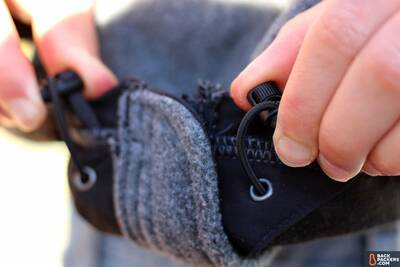
Cinch the hems to your waist and trap in the heat.
You’ll find some cuffs with small circles of elastic material; this helps you push up the sleeves without them slipping and keeps heat in. There are also sleeves that have longer stretchy material; these are even nicer and keep in more heat.
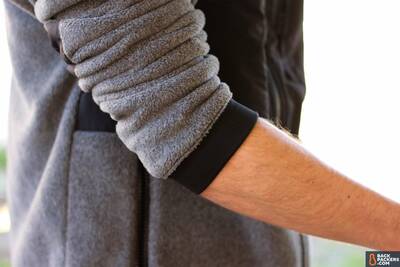
Jersey cuffs are elastic, feel soft, and keep in the heat.
Some fleeces have none of this and are often cheaper because of it.
Fleece Jackets with Thumb Loops
The final feature we’ll highlight is a classic — the thumb loop. Used primarily by the technical crowd, specifically rock climbers, fleece jackets use thumb loops to make the hands warmer and make the coat stay on better. In some models the sleeve actually comes up quite far, providing a glove-like experience for your hand.

Thumb loop plus a mini glove.
This isn’t a deal-breaker for most people, but having thumb loops is usually a plus, as you don’t have to wear them. That said, make sure the sleeves fit you in and out of the thumb loop. Otherwise, the jacket will dangle well past your hands, or pull against your thumbs uncomfortably.
How to Layer Fleece Jackets
When it comes to fleece, you need to consider your layers. This is more critical for backpackers that head into the backcountry for extended trips, as you’ll want to pack sufficiently to be comfortable in all weather scenarios. That said, a solid layering system is a good thing to have if you’re in the city, too.
Fleece, in the lightweight or midweight range, is a solid mid-layer. It goes over a t-shirt or baselayer when it’s cool out.
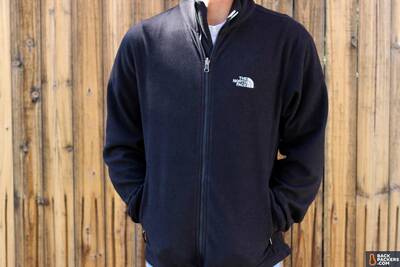
Lightweight fleece as an outer layer for cool temperatures.
And under an outer shell when it’s cold and threatening to rain.
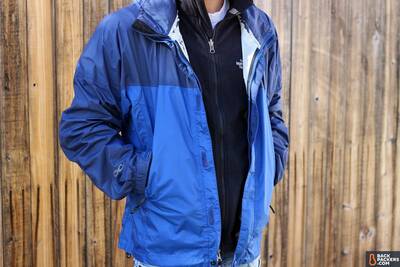
Lightweight fleece plus rain/wind shell for cooler temperatures with inclement weather.
When it’s significantly cold I find fleece to be an excellent secondary mid layer, and put it over a baselayer, under a down or synthetic jacket, which is all under a wind or rain shell.
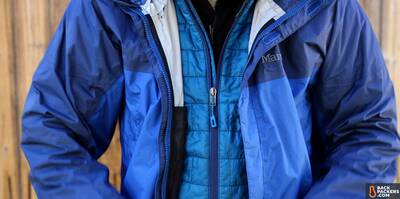
T-shirt, lightweight fleece, down or synthetic puffy, and rain shell. Four layers should keep you prepared in the backcountry.
This four-piece layering system should get you through most temperatures and weather scenarios when paired with a hat, gloves, and solid shoes.
With that full layering system in your thoughts, know that fleece is also a typical outer layer when it’s breezy, but not that cold. Often a down jacket is too warm for 60-degree weather and up — a fleece jacket is a great option. You can zip it open if you heat up, or tie it around your waist when the sun peaks out.
For those who can’t resist the feel of fleece and want a much warmer layer, go with a heavyweight. These fleece jackets are more like outer coats and do more to fend off wind and cold by themselves. Heavyweight fleece jackets will also be bulkier, and won’t layer as nicely.
Good Fleece is Recycled Fleece
Before we wrap this up, it’s important to mention the environmental situation presented by fleece. As you now know, fleece is made from petroleum by way of polyester. Yes, stuff that’s polluting the planet.
Polartec and Patagonia (still in cahoots) began to make polyester fabric out of recycled material, specifically plastic soda bottles, in 1993. It’s called Post Consumer Recycled (PCR) and is used almost exclusively in the outdoor industry. This is especially true with fleece, as it is primarily composed of polyester.
So, when you put on that cozy fleece that was made by a major brand, be aware that it was created from a plastic soda bottle.
Backpacker Types
With the breadth of knowledge above, it’s time to discuss how Backpackers.com looks at fleece jackets for its different Backpacker Types. Our process of research, testing, and recommendation is based on best-use scenarios and is outlined below.
Keep in mind that fleece jackets don’t have nearly the amount of complexities that backpacks do, so we chose many of the same jackets for different Backpacker Types.
Wilderness Backpacker
Fleece jackets for the Wilderness Backpacker are part of the overall layering system in the backcountry. The most important aspect is the fabric weight: a Wilderness Backpacker fleece jacket needs to be lightweight or midweight to layer correctly, pack small, and provide an even amount of warmth and breathability.
Ultralight Backpacker
Similar to the Wilderness Backpacker, the Ultralight Backpacker’s fleece layer should be thin, easily packable, and fit well in a layering system. Extreme Ultralight Backpackers may not take a fleece jacket at all, but those that do will be best served by the same jackets as the Wilderness Backpacker.
Due to fleece’s general measurement system (grams per meter squared), most fleece is in a similar weight range: between 8-11 oz. Obviously, the lighter weight the better, and our recommended fleece jackets reflect that.
Day Hiker
The fleece jackets for Wilderness Backpacker and Ultralight Backpacker are similar for the Day Hiker. You want something that layers well for inclement weather, and, most importantly, breathes. You’re just hiking for the day and are on the move. Our recommended fleece jackets reflect this, with a change in the Budget Pick to be more casual and provide pockets for the more casual user.
Car Camper
Fleece jackets for the Car Camper are a different beast. They are in the midweight or heavyweight range, have a high loft, and are tooled for warmth instead of breathability. These fleece jackets can serve as an outer layer when standing around camp and still fit under a heavy rain shell if it starts to pour.
Most Car Campers relax late into the night around the campfire and drink cocoa in the mornings — our fleece jacket picks reflect this.
Urban Hiker
Fleece jackets for the Urban Hiker have a solid combination of all the above elements, except for extreme layering. They need to be decently warm, serve in a simple layering system, and look good. That last bit — the style — is important. You need a fleece you can take to the bar and the post office.
There is overlap with the other categories, but for the most part, we picked fleece jackets that combine warmth and style to take on the city.
Choosing the Right Fleece Jacket For You
Backpackers.com has chosen certain fleece jackets over others for our different Backpacker Types. We stand by these jackets and feel they are suited to most people. However, not everyone has the same body type, use case, or concept that we do when looking for a solid fleece.
As always, we recommend trying on the jackets to make sure they fit correctly and feel how you want them to. Then think about what you need the jacket for: do you want a piece that layers with all your other gear, a jacket that can serve as an outer layer, or a super cozy coat for watching movies on the couch? Make an informed decision based on this information.
Finally, outdoor gear can add up. Fleece is rare in that most jackets on the market use Polartec, and therefore come with decent materials, often Polartec Classic. If you’re looking to truly pinch pennies (beyond our Budget Picks), check out your local thrift store. Fleece jackets will line the racks, and you can score a very basic fleece for super cheap.
Good luck, and stay cozy.

What is the style of the blue Marmot shell jacket in the layering images, and is it still being produced? It looks great!
Hey Philip,
Thanks for reading and commenting! Yep, the blue Marmot shell is the PreCip, which Marmot does still produce. You can see our review here: https://backpackers.com/outdoor-gear/marmot/rain-jackets/precip-jacket-mens/marmot-precip-review
Great article, thank you.
Excellent article. I thoroughly enjoyed reading the history of one of our backpacking staple items.
Great article! This is a very useful and informative post. Thanks for sharing.
Sounds like the same fabrics are probably used in both expensive and inexpensive clothing, as there is no real ‘magical formula’ here. I would like to see real world testing of clothing for warmth instead of just advertising claims. Am I alone in this?